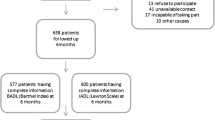Abstract
The purpose of this study was to evaluate whether the ambulatory level premorbid or at discharge reflected the survival rate better. Ambulatory level was retrospectively evaluated as a postoperative indicator of survival rate following operative treatment in 301 consecutive patients over 65 years old. All of the patients were followed up for a mean of 62 months. The postoperative ambulatory level at discharge reliably reflected the survival rate in the elderly after hip fracture, better than the premorbid ambulatory level. It is confirmed that the planning of the operation and rehabilitation to maintain the premorbid ambulatory level after hip fracture might be critical.
Similar content being viewed by others
Author information
Authors and Affiliations
Additional information
Received: 23 June 1999
Rights and permissions
About this article
Cite this article
Imura, K., Ishii, Y., Yagisawa, K. et al. Postoperative ambulatory level after hip fracture in the elderly predicts survival rate. Arch Orth Traum Surg 120, 369–371 (2000). https://doi.org/10.1007/PL00013763
Issue Date:
DOI: https://doi.org/10.1007/PL00013763




